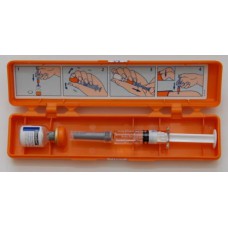Expiration date: 09/2026
The composition and form of issue:
Lyophilisate for preparation of solution for injection. 1 vial contains:
glucagon hydrochloride genetic engineering 1 mg
(corresponding to 1 IU)
excipients: lactose monohydrate water for injections (in the composition may also include hydrochloric acid and/or sodium hydroxide used in the manufacture of the drug for the selection of pH)
in vials of 1 mg of lyophilizate in a set with solvent in disposable syringe 1 ml plastic pencil box 1 vial with lyophilisate and 1 syringe with solvent.
Description pharmaceutical form:
Lyophilized powder or porous mass of white color. When dissolved in the supplied solvent for 1 min forms a clear, colorless solution.
Pharmacokinetics:
The metabolic clearance rate of glucagon in humans is approximately 10 ml/kg/min Glucagon is metabolized enzymatically in blood plasma and in the organs in which it is distributed. The main places of metabolism of glucagon, the liver and kidneys, the contribution of each organ to the total rate of metabolic clearance is approximately 30%. T1/2 of glucagon is 3-6 minutes.
Description pharmacological action:
Glucagen 1 mg Hypokit genetically engineered human glucagon — protein-a peptide hormone, a physiological antagonist of insulin involved in the regulation of carbohydrate metabolism. Glucagon increases the breakdown of glycogen in liver to glucose-6-phosphate (glycogenolysis), resulting in increased concentration of glucose in the blood.
Glucagon is not effective in the treatment of patients in which liver glycogen stores are depleted. For this reason, glucagon is ineffective or not effective in the treatment of undernourished patients on an empty stomach or in patients with adrenal insufficiency, chronic hypoglycaemia or hypoglycaemia caused by drinking alcohol.
Unlike epinephrine, glucagon does not affect muscle phosphorylase and therefore cannot facilitate the transfer of carbohydrates from glycogen stores in skeletal muscle.
Glucagon stimulates the release of catecholamines. In the presence of pheochromocytoma glucagon can provoke a release of tumor a large number of catecholamines, which cause a sharp increase in blood pressure. Glucagon reduces contractility of smooth muscles of the digestive tract.
The action of the drug starts within 1 min after intravenous injection, the duration of action is 5-20 minutes depending on dose and organ. The effect of the drug after the/m injection starts in 5-15 min and lasts 10 to 40 minutes depending on dose and organ.
In the treatment of severe hypoglycemia action of glucagon glucose in the blood is usually observed within 10 min.
Indications:
Severe hypoglycemic state (low blood glucose) occurring in patients with diabetes after injection of insulin or ingestion of tablets hypoglycemic drugs.
Contraindications:
Individual hypersensitivity to glucagon or any component of the drug hyperglycemia pheochromocytoma.
Application of pregnancy and breast-feeding:
Glucagen passes through the human placental barrier and can be used for the treatment of severe hypoglycemia during pregnancy. In appointing the drug in breastfeeding any risk to the baby is not marked.
Side effects:
Severe side effects are very rare.
On the part of the digestive system: sometimes there may be nausea and vomiting, especially with the introduction of a dose of 1 mg or with rapid administration (over at least 1 min).
From the side of cardiovascular system: transient tachycardia, transient increase in blood pressure.
The immune system: hypersensitivity, including anaphylactic shock.
Side effects indicating toxicity of the drug Glucagen not registered.
If the patient experience any adverse reactions, including not listed above, but in his opinion, caused by the use of the drug Glucagen 1 mg Hypokit, he should inform the doctor.
Drug interactions:
On the background of beta-blockers the introduction of the drug Glucagen 1 mg Hypokit can lead to severe tachycardia and increase in blood pressure.
Insulin: the effect of glucagon is opposite to insulin action (insulin antagonist glucagon).
Indomethacin: in a joint application glucagon may lose its ability to raise glucose in the blood and even cause hypoglycemia.
Warfarin: in a joint application glucagon may increase the anticoagulant effect of warfarin.
Method of application and dose:
For the treatment of severe hypoglycemic States
For the preparation of injection solution 1 mg (1 IU) lyophilisate is dissolved in 1 ml of solvent.
Adults and children weighing more than 25 kg or older than 6-8 years administered 1 mg (1 ml mark on the syringe 1/1). Children with body weight less than 25 kg or younger than 6-8 years, injected 0.5 mg (0.5 ml mark on the syringe 1/2) p/or/m. the Patient usually regains consciousness within 10 minutes after administration of the drug. After the patient regains consciousness, he should give food, rich in carbohydrates, to prevent recurrence of hypoglycemia and glycogen restoration in a liver. If within 10 minutes the patient regains consciousness, it is necessary to introduce/dextrose.
All patients with severe hypoglycemia required medical assistance.
Dispose of unused product and packaging in accordance with local requirements.
To diagnose (the suppression of the contractility of the digestive tract)
Glucagen 1 mg Hypokit should be administered only by medical personnel. After the on/in the introduction of 0.2–0.5 mg effect of the drug starts within 1 min and lasts for 5 to 20 min depending on the investigated organ.
After the/m introduction 1-2 mg of the drug action starts in 5-15 min and lasts for 10-40 min depending on the investigated organ. After the procedure the patient need to give carbohydrate-rich foods, if it is compatible with the applicable diagnostic procedure.
Depending on the diagnostic method and the method of administration, the dose is 0.2–2 mg. the Usual diagnostic dose used to relax the muscles of the stomach, duodenal bulb, duodenum and small bowel is 0.2–0.5 mg in/in the introduction and 1 mg in/m introduction. Dose for relaxation of the rectal muscle is 0.5–0.75 mg at/in the introduction 1-2 mg in/m introduction.
Overdose:
In case of overdose of the drug Glucagen 1 mg Hypokit may cause nausea, vomiting, diarrhea, hypokalemia, tachycardia, increased blood pressure.
Treatment is symptomatic. Requires constant monitoring of potassium level and, if necessary, its correction. The use of forced diuresis and hemodialysis are ineffective. In case of vomiting — rehydration and replenish losses potassium.
Special instructions:
After the introduction of the drug Glucagen 1 mg Hypokit necessary to control the content of glucose in the blood plasma.
Glucagen 1 mg Hypokit has a hyperglycemic effect only in the presence of glycogen in the liver, so it will be inefficient for starving patients, in patients with adrenal insufficiency or chronic hypoglycemia or if hypoglycemia is caused by excessive consumption of alcohol.
Care should be taken when using the drug Glucagen 1 mg Hypokit in patients with insulinoma or glucagonoma.
A diabetic patient should strictly adhere to medical recommendations aimed at preventing hypoglycemic conditions.
You can't use the solution if it looks like a gel or if the powder has not completely dissolved.
The vial has a protective, heat-resistant plastic cap with color code.
To dissolve the powder drug Glucagen 1 mg Hypokit, you must remove the plastic cap. If it is lost or missing when you purchase a bottle, return the bottle to the pharmacy.
Storage conditions:
The finished solution of the preparation should be used immediately after preparation. Do not store the diluted solution for later use.


